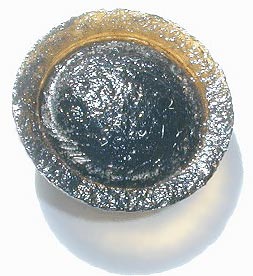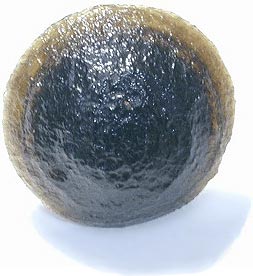
The two sides of a tektite button,
courtesy of Janet Mears, an Australian tektite collector.
 |
Tektites are small black glassy artifacts, a kind of meteorite, for a time thought to be emanating from the Moon.
They are subdivided according to the strewn area (usually elliptical) in which they are found, eg the Australites are found in the deserts and salt pans of Western Australia, but also extend over South Australia, Victoria and Tasmania. The Indochinites are found in Indochina, the Moldavites in Eastern Europe and the Georgiaites in SE United States.
Their compositions resemble terrestrial obsidians with a silica content in the range 75 – 83% and their fingerprint is definitely continental. It is now believed that occasionally a meteorite strikes the Earth in a low oblique path and on impact ejects a shower of impactite melt droplets at a low trajectory. Rotation and spinning may impart odd shapes to droplets of melt, eg as balls, dumbells etc but the strangest are the "buttons". Only a cm or two across, the are basically a ball of glass but in which the leading edge of a melt droplet has been modified by high speed passage through air. The surface drags towards the rear forming ripples and a marked collar. The collar may break off entirely but is so fragile it is seldom found except when recovered from marine sediments.
| |__| |
Fingerprint diagram for averages of Georgiaites, two Indochinites and a Modavite. The silica ranges from 78 – 83%, presumably varying with the degree of melt. Taken from Norman,M., and Roden. M., Lunar & Planetary Science XXlX, "Crustal Components in North American Tektites". |
|